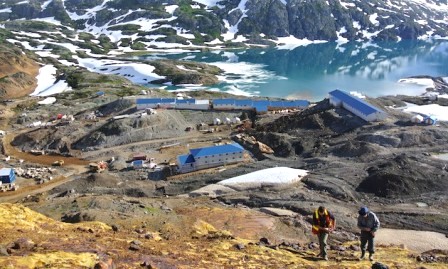
Pretivm Resources’ Valley of the Kings discovery on the Brucejack property in Northern B.C. is just about the best Canadian gold project in the hands of a development company right now. It’s got grade, size, low CapEx and ease of permitting all going for it.
The recent sell off in gold and related equities has taken no prisoners — like most other companies in the market, Pretivm shares have fallen over 60% this year (Stock Profile – TSX:PVG & NYSE:PVG) .
In light of the downturn, we wanted to get a better sense of the project and the opportunity it offers, so we turned to CEO Bob Quartermain for the Pretivm lowdown. We also had the privilege of getting a better sense of the veteran explorer behind the project along the way.
Pretium’s Quartermain
Born and raised in New Brunswick, Canada, Bob Quartermain developed a passion for the Canadian north as a young man, and has been an exploration geologist focused there ever since. His big break happened in 1980 with the Hemlo gold discovery in Northern Ontario. Quartermain, as project manager, spent three years drilling off the David Bell mine for Teck Resources (Stock Profile – TSX:TCK.B & NYSE:TCK) and contributed to the underground mine plan that would eventually yield one of Canada’s most profitable gold mines.
It was a phone call from the young Quartermain that set off the market frenzy — he and Bruce Durham were the first to recognize the significance of the First Goliath drill core. “You could just see it. It was this moly-rich, sucrosic, beautiful, grayish-blue gold bearing rock. We started opening drill core boxes — and each box contains 15 feet of core — and we ultimately opened up six of them: 90 feet in total, and it was all the same moly-rich rock.”
The young geologist went to the nearest payphone to relay a rough visual assay of 90 feet of 1/4 ounce per tonne gold to his employer Teck. “The person on the other end of the phone didn’t seem so impressed,” Quartermain recalled. But by the time he got back to his hotel room, there were frantic messages for him to call the president of the company.
The market in Vancouver went wild. Soon, penny shares of Hemlo area companies were trading as high as $90. When true assays of the drill core came out to 92 feet of .256 ounces gold, Quartermain’s intuition was validated. From that point on, his company and others trusted him.
After Hemlo in 1985, the humble Maritime geologist took the reigns of Silver Standard (Stock Profile – TSX:SSO & NASDAQ:SSRI), another Teck company. By the time Bob retired in 2010, it was a $2 billion silver producer; it had started at just $1.8 million.

“When I came to Vancouver, I didn’t own a suit, I’d never read a balance sheet, never met a lawyer, and I only knew one broker. But they threw me in the fray of running a junior company, and it panned out, because we focused on sound geology.” With the backing of investors like Rick Rule and Jim Blanchard, the company grew by exploration and acquisition.
Sound geology is what led Quartermain to purchase the Brucejack property from Silver Standard in 2010. He wanted out of retirement and was convinced it was one of the best gold exploration projects in the world.
Brucejack was sold, along with the neighboring Snowfield project (which contains a staggering 34 million ounces of low grade gold — a proxy on a higher gold price) to Pretivm for approximately $450 million in cash and shares. But the focus has always been on locating the potential high grade gold at Brucejack.
In the two and a half years since the sale, Pretivm has defined a spectacular high-grade resource. “In 2009 we had 400,000 ounces of gold and 16 million ounces of silver at Brucejack. The Valley of the Kings area at that time just had a half a dozen drill holes. Between 2010 and 2012, we drilled 174,000 meters and now have over 8.5 million ounces at 16.4 grammes per tonne gold open at depth and in all directions.”
In this day and age, gold projects with the richness and size of Brucejack and the jurisdictional advantage of being in Canada and close to current and former mines like Eskay Creek are rare. Pretivm is in a league of its own among junior companies.
Analysts at BMO seem to agree, commenting that Brucejack is “the right size for the current market environment.” Its underground mine will be finished in 2016; Quartermain says it is projected to cost approximately 600 million dollars and yield over 400,000 ounces of gold per year.
Pretivm clearly beats out the other large-scale gold projects in Canada — almost all of which are low grade, requiring Capex in the multiple billions, which isnt realistic in today’s market environment.
Presently, ten research firms are covering the company with an average target price of greater than $20 per share. Shares in PVG last traded at $6.01.
We contacted economic geologist and editor of Exploration Insights’ Brent Cook to explain this disconnect. Cook told us, “The question everyone has is continuity of the high grade. Bob is addressing that via a bulk sample. The results should answer a lot of people’s questions. I’m actually pretty interested in Brucejack and would love to visit the project this year.”
Results from a 5×5 meter bulk sample from the pay zone at the Valley of the Kings are expected in the second half of 2013. A feasibility study on the economics of Brucejack is also expected early this summer, rounding out the near-term catalysts.
Infrastructure (there is road access), water (they’ll likely generate their own water underground – it’s a wet area), permitting and politics are less of a worry to Quartermain and analysts. Grade continuity is the main focus. If demonstrated, along with expected and positive economics, Brucejack could be one of the few bright spots in the mining industry in 2013.
I asked Quartermain whether his plan was to sell Brucejack or develop it into a mine. He told me his plan is to get the best value possible. “Two years ago, selling the project may have been very likely,” he said. “Right now the major companies are focusing on organic pipelines, and their interest will depend on the bulk sample and feasibility. If they both deliver what we feel they will, the project will be very robust, and we think they’ll be interested.”
The fact that Quartermain built Silver Standard into a profitable precious metals producer makes us confident that if they can’t find a buyer, they can move toward its stated 2016 production commencement timeline on its own.
We chatted for a few more minutes before Bob had to leave Vancouver for Europe, then on to the Middle East to catch up with investors. “It’s important to see the owners of the company, and we like to visit our large investors a few times per year,” he told us.
“There hasn’t been another Hemlo find, and I was fortunate to sit on that discovery. Brucejack may be as significant,” Quartermain said. “I should be so lucky.”
The Prospectors and Developers Association of Canada seem to agree with Quartermain, having awarded Pretivm the 2013 Bill Dennis Award for a prospecting success.



 Follow us on Twitter
Follow us on Twitter Become our facebook fan
Become our facebook fan











Comments are closed.